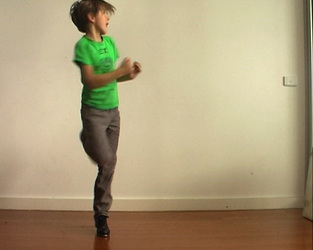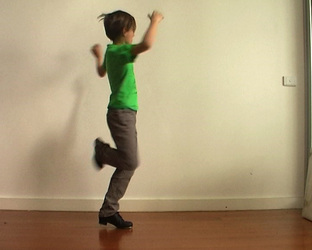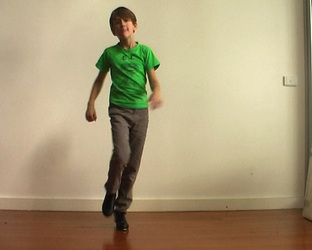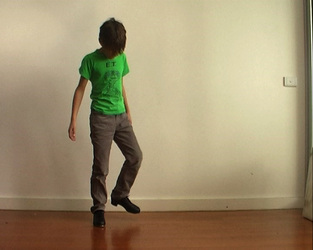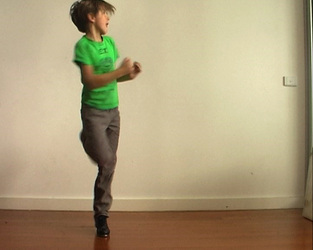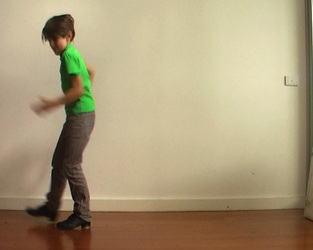Julia Powles Dancing Without Lessons, Video, 6.8min 2010
In Dancing Without Lessons a boy who is desperate to be able to dance believes that the new pair of tap shoes he has just been bought are enough to make him a dancer. Caught up in the moment of creation the boy improvises a routine that can never be repeated.
'The Moment when you think that's all it takes...'
There are degrees to whether or not one can or can’t do something and this is generally based on criteria. Julia Powles’ video work Dancing Without Lessons is about the memory of a time before knowledge, doing something from an uninformed position, a moment of free expression outside of the boundaries of reason and convention, an instance of ‘on the spot’ ad-libbing. Dancing Without Lessons is about doing something without preconception to define an event based on belief. Dancing Without Lessons is a seemingly minimal work as it defines a moment where nothing apparently happens, but just so much is occurring, and there is so much to take our attention.
Powles’ video is about not waiting and not standing still for a moment, but rather putting everything you’ve got into the moment in order to will something into being. Dancing Without Lessons subverts the idea that there is a particular way to do something or an order to things, challenging the authority of the systems through which we have learnt things within society. Powles determines a moment in time that can never be recaptured (as the boy has since had lessons), making a work that is primarily about desire and belief, where what someone understands to be dancing has been made up, through looking, through the observation of music video clips and an encounter with a tap dancer performing in a carpark.
Can any of us locate the moment in our childhood when knowledge replaced imagination as our primary means of understanding the world?
In most of our lives we’ve hopefully encountered playing and pretence, trying to become something else through an un-fettered and free expression. But what does it mean to think you can do something without ever really having tried it? Powles considers that we often: “glimpse the possibility for another and less structured understanding of the world; an understanding that involves self-creation. One in which the world we know is in transformation from one state of being into another and where the dancing boy creates his own reality. He can dance.”
…
Powles’ practice spans video and painting. Past works in video have explored ideas of spaces that exist as in between states, or as passages. In these works Powles suggests the idea of passing from one place to another, or from one stage in life to another. Some of these earlier works also attempted to invoke the sense of being overwhelmed by a moment or a passage in time, by our recognition of how in our lives we may exist at the centre of something incomprehensible.
Powles’ video work Drift (2007), multiple screens showing slow moving footage of the rolling and grey surface of the ocean, interspersed with other footage of the seemingly futile action of a lone swimmer, dealt with a threat and an attraction to absolute or complete immersion, a commingling of bewilderment and struggle within the notion of being captured by the incredible.
North Melbourne Scum (2008) is video footage following the short journey of a piece of driftwood along the passage of an open city drain. The driftwood is immersed in yellow and polluted foam, while the soundtrack of a conversation between Powles and two adolescent males can be overheard. The boys, who are strangers to Powles, and have approached her through curiosity, seeing her film the drain, explain and demonstrate (due to the unnerving sounds of nearby crashing feet) the various movements and stunts involved in parkour. The soundtrack is infused with a sense of excitement and possible danger – the encounter of Powles with the adolescents in an isolated location, coupled with the ‘risk taking’ implied through the parkour stunts, and the sense of detritus embodied in the driftwood on its meaningless and uneventful journey suggests how we exist at a mediated edge point of chance, threat, mishap and control.
Tailgating (2008), places the viewer in the position of passive participant. Cars are randomly followed throughout the city at nighttime. The headphones play a selection of Patsy Cline songs for easy listening creating that space that we all enter into momentarily when we drive at night. Tailgating defines a moment of realization when we know we can change our minds, when we recognize that we don’t have to go where we are intending to, and we simply contemplate the idea of another outcome. Following any of the cars ahead could offer us direction and it is our ability to choose wisely that becomes the focus. And a journey, by definition, goes somewhere, so the expectation of arrival is constantly frustrated in Tailgating, leaving us instead with the contrast of movement and stasis, and the uncomfortable suggestion that these two states may in fact be the same thing.
Powles always places you, her protagonist, as a witness to the ongoing conundrum of life as unfathomable, but marked by potential.
The boy in Dancing Without Lessons will learn to dance. The car will arrive. The swimmer will survive the swim and there is a probability nothing untoward that will happen. However these passages are marked by uncertainty, by not knowing the outcome, by attempting to do something without knowing if you really can.
Peter Westwood
Peter Westwood is an artist, writer and curator based in Melbourne.
There are degrees to whether or not one can or can’t do something and this is generally based on criteria. Julia Powles’ video work Dancing Without Lessons is about the memory of a time before knowledge, doing something from an uninformed position, a moment of free expression outside of the boundaries of reason and convention, an instance of ‘on the spot’ ad-libbing. Dancing Without Lessons is about doing something without preconception to define an event based on belief. Dancing Without Lessons is a seemingly minimal work as it defines a moment where nothing apparently happens, but just so much is occurring, and there is so much to take our attention.
Powles’ video is about not waiting and not standing still for a moment, but rather putting everything you’ve got into the moment in order to will something into being. Dancing Without Lessons subverts the idea that there is a particular way to do something or an order to things, challenging the authority of the systems through which we have learnt things within society. Powles determines a moment in time that can never be recaptured (as the boy has since had lessons), making a work that is primarily about desire and belief, where what someone understands to be dancing has been made up, through looking, through the observation of music video clips and an encounter with a tap dancer performing in a carpark.
Can any of us locate the moment in our childhood when knowledge replaced imagination as our primary means of understanding the world?
In most of our lives we’ve hopefully encountered playing and pretence, trying to become something else through an un-fettered and free expression. But what does it mean to think you can do something without ever really having tried it? Powles considers that we often: “glimpse the possibility for another and less structured understanding of the world; an understanding that involves self-creation. One in which the world we know is in transformation from one state of being into another and where the dancing boy creates his own reality. He can dance.”
…
Powles’ practice spans video and painting. Past works in video have explored ideas of spaces that exist as in between states, or as passages. In these works Powles suggests the idea of passing from one place to another, or from one stage in life to another. Some of these earlier works also attempted to invoke the sense of being overwhelmed by a moment or a passage in time, by our recognition of how in our lives we may exist at the centre of something incomprehensible.
Powles’ video work Drift (2007), multiple screens showing slow moving footage of the rolling and grey surface of the ocean, interspersed with other footage of the seemingly futile action of a lone swimmer, dealt with a threat and an attraction to absolute or complete immersion, a commingling of bewilderment and struggle within the notion of being captured by the incredible.
North Melbourne Scum (2008) is video footage following the short journey of a piece of driftwood along the passage of an open city drain. The driftwood is immersed in yellow and polluted foam, while the soundtrack of a conversation between Powles and two adolescent males can be overheard. The boys, who are strangers to Powles, and have approached her through curiosity, seeing her film the drain, explain and demonstrate (due to the unnerving sounds of nearby crashing feet) the various movements and stunts involved in parkour. The soundtrack is infused with a sense of excitement and possible danger – the encounter of Powles with the adolescents in an isolated location, coupled with the ‘risk taking’ implied through the parkour stunts, and the sense of detritus embodied in the driftwood on its meaningless and uneventful journey suggests how we exist at a mediated edge point of chance, threat, mishap and control.
Tailgating (2008), places the viewer in the position of passive participant. Cars are randomly followed throughout the city at nighttime. The headphones play a selection of Patsy Cline songs for easy listening creating that space that we all enter into momentarily when we drive at night. Tailgating defines a moment of realization when we know we can change our minds, when we recognize that we don’t have to go where we are intending to, and we simply contemplate the idea of another outcome. Following any of the cars ahead could offer us direction and it is our ability to choose wisely that becomes the focus. And a journey, by definition, goes somewhere, so the expectation of arrival is constantly frustrated in Tailgating, leaving us instead with the contrast of movement and stasis, and the uncomfortable suggestion that these two states may in fact be the same thing.
Powles always places you, her protagonist, as a witness to the ongoing conundrum of life as unfathomable, but marked by potential.
The boy in Dancing Without Lessons will learn to dance. The car will arrive. The swimmer will survive the swim and there is a probability nothing untoward that will happen. However these passages are marked by uncertainty, by not knowing the outcome, by attempting to do something without knowing if you really can.
Peter Westwood
Peter Westwood is an artist, writer and curator based in Melbourne.
